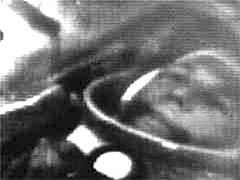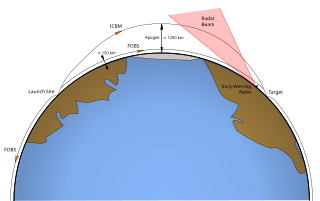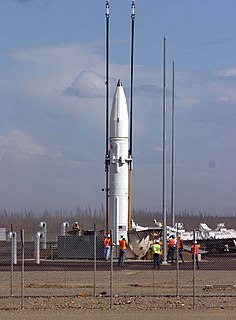
Human spaceflight is spaceflight with a crew or passengers aboard a spacecraft, the spacecraft being operated directly by the onboard human crew. Spacecraft can also be remotely operated from ground stations on Earth, or autonomously, without any direct human involvement. People trained for spaceflight are called astronauts, cosmonauts, or taikonauts; and non-professionals are referred to as spaceflight participants.

Vostok 1 was the first spaceflight of the Vostok programme and the first human spaceflight in history. The Vostok 3KA space capsule was launched from Baikonur Cosmodrome on April 12, 1961, with Soviet cosmonaut Yuri Gagarin aboard, making him the first human to cross into outer space.

A spacecraft is a vehicle or machine designed to fly in outer space. A type of artificial satellite, spacecraft are used for a variety of purposes, including communications, Earth observation, meteorology, navigation, space colonization, planetary exploration, and transportation of humans and cargo. All spacecraft except single-stage-to-orbit vehicles cannot get into space on their own, and require a launch vehicle.

Spaceflight is an application of astronautics to fly spacecraft into or through outer space, either with or without humans on board. Most spaceflight is uncrewed and conducted mainly with spacecraft such as satellites in orbit around Earth, but also includes space probes for flights beyond Earth orbit. Such spaceflight operates either by telerobotic or autonomous control. The more complex human spaceflight has been pursued soon after the first orbital satellites and has reached the Moon and permanent human presence in space around Earth, particularly with the use of space stations. Human spaceflight programs include the Soyuz, Shenzhou, the past Apollo Moon landing and the Space Shuttle programs, with currently the International Space Station as the main destination of human spaceflight missions while China's Tiangong Space Station is under construction.

The Space Race was a 20th-century competition between two Cold War adversaries, the Soviet Union (USSR) and the United States of America (USA), to achieve superior spaceflight capability. It had its origins in the ballistic missile-based nuclear arms race between the two nations following World War II. The technological advantage demonstrated by spaceflight achievement was seen as necessary for national security, and became part of the symbolism and ideology of the time. The Space Race brought pioneering launches of artificial satellites, robotic space probes to the Moon, Venus, and Mars, and human spaceflight in low Earth orbit and ultimately to the Moon.
The original meaning of the word shuttle is the device used in weaving to carry the weft. By reference to the continual to-and-fro motion associated with that, the term was then applied in transportation and then in other spheres. Thus the word may now also refer to:
Human spaceflight programs have been conducted, started, or planned by multiple countries and companies. Until the 21st century, human spaceflight programs were sponsored exclusively by governments, through either the military or civilian space agencies. With the launch of the privately funded SpaceShipOne in 2004, a new category of human spaceflight programs – commercial human spaceflight – arrived. As of July 2021, three countries and one private company (SpaceX) have launched humans to Earth orbit, and two private companies have launched humans on a suborbital trajectory. The criteria for what constitutes human spaceflight vary. The Fédération Aéronautique Internationale defines spaceflight as any flight over 100 kilometers (62 mi). In the United States professional, military, and commercial astronauts who travel above an altitude of 80 kilometers (50 mi) are awarded the United States Astronaut Badge. This article follows the FAI definition of spaceflight.

The Sputnik crisis was a period of public fear and anxiety in Western nations about the perceived technological gap between the United States and Soviet Union caused by the Soviets' launch of Sputnik 1, the world's first artificial satellite. The crisis was a significant event in the Cold War that triggered the creation of NASA and the Space Race between the two superpowers. The satellite was launched on October 4, 1957, from the Baikonur Cosmodrome. This created a crisis reaction in national newspapers such as the New York Times, which mentioned the satellite in 279 articles between October 6, 1957, and October 31, 1957.

Columbus is a science laboratory that is part of the International Space Station (ISS) and is the largest single contribution to the ISS made by the European Space Agency (ESA).

A reusable launch system is a launch system that allows for the reuse of some or all of the component stages. To date, several fully reusable suborbital systems and partially reusable orbital systems have been flown.
Kosmos is a designation given to many satellites operated by the Soviet Union and subsequently Russia. Kosmos 1, the first spacecraft to be given a Kosmos designation, was launched on 16 March 1962.

A spaceplane is a vehicle that can fly and glide like an aircraft in Earth's atmosphere and maneuver like a spacecraft in outer space. To do so, spaceplanes must incorporate features of both aircraft and spacecraft. Orbital spaceplanes tend to be more similar to conventional spacecraft, while sub-orbital spaceplanes tend to be more similar to fixed-wing aircraft. All spaceplanes to date have been rocket-powered but then landed as unpowered gliders.

The Fractional Orbital Bombardment System (FOBS) was a nuclear-weapons delivery system developed in the 1960s by the Soviet Union. One of the first Soviet efforts to use space to deliver weapons, FOBS envisioned launching nuclear warheads into low Earth orbit before bringing them down on their targets.

A Moon landing is the arrival of a spacecraft on the surface of the Moon. This includes both crewed and robotic missions. The first human-made object to touch the Moon was the Soviet Union's Luna 2, on 13 September 1959.
Space weapons are weapons used in space warfare. They include weapons that can attack space systems in orbit, attack targets on the earth from space or disable missiles travelling through space. In the course of the militarisation of space, such weapons were developed mainly by the contesting superpowers during the Cold War, and some remain under development today. Space weapons are also a central theme in military science fiction and sci-fi video games.

The militarisation of space involves the placement and development of weaponry and military technology in outer space. The early exploration of space in the mid-20th century had, in part, a military motivation, as the United States and the Soviet Union used it as an opportunity to demonstrate ballistic-missile technology and other technologies having the potential for military application. Outer space has since been used as an operating location for military spacecraft such as imaging and communications satellites, and some ballistic missiles pass through outer space during their flight. As of 2019 known deployments of weapons stationed in space include only the Almaz space-station armament and pistols such as the TP-82 Cosmonaut survival pistol.

The Kistler K-1 was a two-stage, fully reusable launch vehicle design created by Kistler Aerospace. It was to accommodate a wide range of missions, including payload delivery to low Earth orbit (LEO), payload delivery to high-energy orbits with a K-1 Active Dispenser, technology demonstration flights, microgravity missions, and commercial cargo resupply, recovery, and reboost services for the International Space Station (ISS).

Buran was the first spaceplane to be produced as part of the Soviet/Russian Buran programme. Besides describing the first operational Soviet/Russian shuttle orbiter, "Buran" was also the designation for the entire Soviet/Russian spaceplane project and its orbiters, which were known as "Buran-class orbiters".

Spaceflight began in the 20th century following theoretical and practical breakthroughs by Konstantin Tsiolkovsky, Robert H. Goddard, and Hermann Oberth. First successful large-scale rocket programs were initiated in the 1920s Germany by Fritz von Opel and Max Valier, and eventually in Nazi Germany by Wernher von Braun. The Soviet Union took the lead in the post-war Space Race, launching the first satellite, the first man and the first woman into orbit. The United States caught up with, and then passed, their Soviet rivals during the mid-1960s, landing the first man on the Moon in 1969. In the same period, France, the United Kingdom, Japan and China were concurrently developing more limited launch capabilities.

Development of the Commercial Crew Program began in the second round of the Commercial Crew Development (CCDev) program, which was rescoped from a technology development program for human spaceflight to a competitive development program that would produce the spacecraft to be used in the Commercial Crew Program to provide crew transportation services to and from the International Space Station (ISS). To implement the program NASA awarded a series of competitive fixed-price contracts to private vendors starting in 2011. Operational contracts to fly astronauts were awarded in September 2014 to SpaceX and Boeing. Each company performed an uncrewed orbital test flight in 2019, and operational flights started in November 2020.














